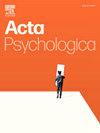Perceived ability and influencing factors of the signage system for color vision deficiency groups: A case study of metro travel process
IF 2.1
4区 心理学
Q2 PSYCHOLOGY, EXPERIMENTAL
引用次数: 0
Abstract
Introduction
Color plays a crucial role in wayfinding signage, enhancing information filtering and reception. However, individuals with color vision deficiency (CVD) struggle to interpret color-coded information, impeding navigation and daily mobility. With the rapid development of urban rail transit in China, metro systems rely heavily on color-coded signage, exacerbating challenges for CVD individuals. Existing research focuses mainly on digital interfaces, with limited attention to how CVD groups perceive signage in complex environments, highlighting the need for studies addressing their wayfinding difficulties.
Methods
This study examines the metro transit process at Lücuo Station in Xiamen, selecting two critical spatial nodes in urban streets and two within the station. Utilizing eye-tracking technology, 360° panoramic imaging, and CVD simulation techniques, the research considers daytime versus nighttime conditions and normal color vision (NCV) versus CVD. A total of 94 participants were recruited, yielding 88 valid datasets. Four eye-tracking experiments were conducted, employing variance and correlation analysis to compare visual metrics. The study explores signage perception across complex environments and examines how color contrast affects visibility and readability under varying conditions.
Results
Experimental results indicate that at certain experimental nodes, simulated CVD participants were approximately 30 % slower in noticing existing signage and 50 % slower in decision-making compared to participants with NCV. However, in environments with complex color schemes, simulated CVD participants demonstrated superior performance, detecting existing signage 40–55 % faster than their NCV counterparts, showing resistance to interference from visually rich color environments. Furthermore, variations in outdoor lighting conditions significantly impacted participants' signage perception abilities by affecting the contrast between signage and environment.
Conclusions
This study explores subway signage perception by CVD users, highlighting challenges with non-color-friendly designs and poor nighttime lighting. CVD users filter distractions better in complex visuals but struggle with low contrast. This research advocates inclusive urban design, offering a foundation for future accessibility improvements.
色觉缺陷人群标识系统感知能力及影响因素——以地铁出行过程为例
色彩在导视标志中起着至关重要的作用,增强了信息的过滤和接收。然而,有色觉缺陷(CVD)的人很难理解颜色编码的信息,妨碍了导航和日常行动。随着中国城市轨道交通的快速发展,地铁系统严重依赖彩色标识,加剧了心血管疾病患者的挑战。现有的研究主要集中在数字接口上,对CVD群体如何在复杂环境中感知标牌的关注有限,强调需要研究解决他们的寻路困难。方法选取城市街道上的两个关键空间节点和车站内的两个关键空间节点,对厦门厝站的地铁交通过程进行研究。利用眼动追踪技术、360°全景成像和CVD模拟技术,该研究考虑了白天与夜间条件以及正常色觉(NCV)与CVD。共招募了94名参与者,产生了88个有效数据集。进行了四次眼动追踪实验,采用方差分析和相关分析对视觉指标进行比较。该研究探讨了复杂环境下的标识感知,并研究了不同条件下颜色对比如何影响可见性和可读性。结果实验结果表明,在特定的实验节点,模拟CVD参与者在注意到现有标志方面比NCV参与者慢约30%,在决策方面比NCV参与者慢约50%。然而,在具有复杂配色方案的环境中,模拟CVD参与者表现出优异的表现,检测现有标识的速度比NCV参与者快40 - 55%,显示出对视觉丰富色彩环境干扰的抵抗力。此外,室外照明条件的变化通过影响标识和环境之间的对比显著影响了参与者的标识感知能力。本研究探讨了CVD用户对地铁标识的感知,突出了非色彩友好设计和夜间照明不足的挑战。CVD用户在复杂的视觉效果中更好地过滤干扰,但在低对比度下却很挣扎。本研究倡导包容性城市设计,为未来的可达性改善奠定基础。
本文章由计算机程序翻译,如有差异,请以英文原文为准。
求助全文
约1分钟内获得全文
求助全文
来源期刊

Acta Psychologica
PSYCHOLOGY, EXPERIMENTAL-
CiteScore
3.00
自引率
5.60%
发文量
274
审稿时长
36 weeks
期刊介绍:
Acta Psychologica publishes original articles and extended reviews on selected books in any area of experimental psychology. The focus of the Journal is on empirical studies and evaluative review articles that increase the theoretical understanding of human capabilities.
 求助内容:
求助内容: 应助结果提醒方式:
应助结果提醒方式:


